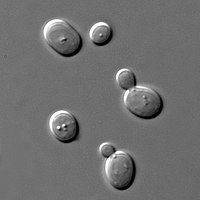
Photo from wikipedia
Abstract The antioxidant potential of the ethanolic precipitate (EP) of the marine green alga Ulva rigida was evaluated via its scavenging ability on 1, 1-dipheny-2-picrylhydrazyl (DPPH) and cytoprotection against H2O2-induced… Click to show full abstract
Abstract The antioxidant potential of the ethanolic precipitate (EP) of the marine green alga Ulva rigida was evaluated via its scavenging ability on 1, 1-dipheny-2-picrylhydrazyl (DPPH) and cytoprotection against H2O2-induced damage in yeast cells and zebrafish embryos. The EP exhibited substantially stronger DPPH scavenging activity (92.5%) at 1 μg/mL than the positive control, gallic acid (84%) at 18 μg/mL. Pretreatment with different concentrations of EP (0.005, 0.3, 0.5 or 1 μg/mL) significantly protected yeast cell and zebrafish embryo from death induced by H2O2 and blocked H2O2-induced modifications of superoxide dismutase (SOD) and catalase (CAT) activities when administrated at 0.3 μg/ml. The protective effect of the EP was comparable to the effect produced by the antioxidant, N-acetylcysteine (NAC) at 50 μM. In addition, the antioxidant potential of the EP was stable up to a temperature of 60 °C. In sum, these findings demonstrate that the PE of U. rigida exhibited a preventive action against H2O2-induced oxidative stress.
Journal Title: South African Journal of Botany
Year Published: 2017
Link to full text (if available)
Share on Social Media: Sign Up to like & get
recommendations!